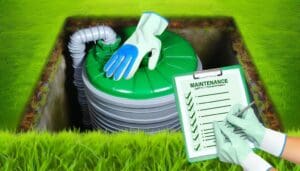Discover how to protect your septic system from breakdown with...
Read MoreYou & Your Septic Tank
Don't Believe Everything You Hear About Septic Tanks
Our professional septic service team offers comprehensive septic tank pumping services to keep your system running smoothly. Get a FREE Quote Today.

Don’t Believe Everything You Hear About Septic Tanks
As a septic tank expert, there’s one thing that I want you to know: don’t believe everything you hear about septic tanks. Too often, homeowners get the wrong information and it can lead to costly mistakes or even damage their system. In this article, I’ll explain why it’s so important not to trust every bit of advice on septic tanks and what you should do instead.
Septic tanks are essential components in many homes but they’re also complex systems that require specialized knowledge for proper maintenance and repair. That’s why it’s important to have an experienced professional who knows how these systems work and what needs to be done when something goes wrong. Unfortunately, too much bad information makes its way around which can cause serious problems if followed blindly.
From DIY guides offering quick fixes with no understanding of the underlying causes of a problem to old wives’ tales passed down from generation to generation, the sheer amount of misinformation out there is staggering. To make matters worse, some myths actually sound reasonable enough that people assume they must be true – until costly repairs need to be made! But fear not – in this article I’m going to help set the record straight by debunking some common misconceptions about septic tanks and explaining what you should do instead.
Definition Of Septic Tanks
Septic tanks are an essential part of many homes in the U.S., with over 15 million households relying on a septic system for their wastewater disposal needs. Understanding what exactly a septic tank is and how it works can be confusing, so let’s break down the definition of septic tanks and systems to get a better understanding.
A septic tank is essentially an underground container that holds wastewater from your home before it is dispersed into the soil by means of drain fields. The purpose of this tank is to allow solids, grease, fat and other substances to settle at the bottom while liquid waste passes through. This process helps reduce bacteria and viruses in the water before it enters the environment.
The second part of a septic system consists of drain fields, also known as leach lines or absorption beds. These consist of perforated pipes beneath the surface covered by gravel which disperses wastewater into nearby soil where additional filtration takes place before entering groundwater sources like rivers, lakes and streams. It’s important to note that both parts must work together properly for optimal performance – if either fails there could be serious consequences when it comes to health, safety and environmental concerns.
This has been a brief overview on what a septic tank is and how they function within a septic system – now onto common misconceptions about these vital components…
Common Misconceptions
Septic tanks have been a part of modern society since the late 1800s. Unfortunately, over time numerous myths and falsehoods about them have developed amongst the general public. It is important to recognize septic-tank-lies, septic-tank-misinformation, and septic-tank-falsehoods so that you don’t fall victim to rumors that lead to costly repairs or replacements.
One common misconception is that any kind of liquid can be poured down the drain without consequence. This couldn’t be farther from the truth; it’s essential to only pour approved liquids into your system as nonapproved substances can clog up pipes or cause other damage. Additionally, many people mistakenly believe that a tank will never fill up – this isn’t true either! Septic tanks need regular maintenance in order for them to properly function.
Another myth suggests that anything flushed down the toilet gets broken down by bacteria in the tank itself. In reality, large objects such as baby wipes should not go in at all due to their potential for blocking pipes and causing serious issues with drainage flow. Furthermore, bleach is often seen as safe but too much can actually kill off beneficial bacteria which are necessary for breaking down solids – leading to backups and overflows.
It’s vital to understand what goes into your septic tank before disposing items down drains or toilets; improper care leads to expensive repair costs and even larger headaches than if proper precautions were taken in advance. To avoid these issues, start by understanding proper maintenance procedures…
Proper Maintenance Procedures
Maintaining a septic tank is like taking care of a pet. Regularly checking in on it and giving it the proper attention can make all the difference between an efficient system that runs smoothly or one that’s constantly breaking down.
To keep your septic tank running optimally, here are 4 key tips you should know:
- Schedule regular pumping – You should have your septic tank pumped out every 3-5 years depending on usage to prevent overflow and ensure efficiency.
- Keep an eye on water use – Monitor how much water you’re using throughout the day so that you don’t overload your system.
- Maintain records – Track when your last pump was as well as any other maintenance performed by keeping detailed records of each visit.
- Watch what goes down the drain – Avoid putting anything into the septic system that could cause clogs or damage such as grease, coffee grounds, paper towels, etc.
Keeping up with these simple steps will help maintain your septic system so it continues to function properly for years to come. However, if not maintained correctly there can be potential health hazards associated with a malfunctioning septic system.
Potential Health Hazards
Septic tanks can be hazardous to your health if not properly maintained. Contamination from a septic tank overflow or sewage backup can lead to the spread of bacteria and other harmful micro-organisms. The gases that build up in a septic tank, such as methane and hydrogen sulfide, are also dangerous when inhaled for extended periods of time. Septic tanks should be checked regularly for evidence of overflowing or leaking, which could result in contaminated runoff into nearby environment areas.
Proper maintenance is key to avoiding any potential hazards associated with septic tanks. If you suspect any issues with your tank, it’s important to contact a professional immediately so they can inspect the system and take corrective action before further damage occurs. Additionally, regular pumping services help keep your tank functioning properly and prevent buildup of sludge and solid waste material in the bottom of the tank. This reduces the risk of overflows and backups that could potentially cause an environmental hazard.
By following these precautions, you can ensure that your septic system remains safe and free of contamination. Knowing how to recognize signs that something might be wrong with your system allows homeowners to quickly address any problems before they have serious consequences on their property or local environment. As we move onto discussing different types of septic systems available, it’s important to remember that proper maintenance is essential for keeping them working correctly and preventing any health risks associated with them.
Types Of Septic Systems
Though it may be easy to believe the horror stories about septic tanks, there are various types of systems that can help prevent potential health hazards. As a specialist in this field, I know all too well how important it is to have an understanding of the different kinds available and what they entail.
The first type of system is known as gravity systems. This involves using pipes and trenches to transport wastewater throughout your home’s plumbing system into a tank underground. Gravity helps move waste through the system until it reaches its final destination – usually a drainfield for disposal. Gravity systems tend to require less maintenance over time than other types due to their simple design and lack of pumps or filters.
Aerobic systems use oxygen-rich air pumped into the septic tank which helps break down solid material much faster than traditional gravity systems. The added oxygen increases bacterial activity within the tank, speeding up decomposition significantly during peak usage periods or when large amounts of solids accumulate in the tank. Aerobic systems also typically feature additional filtration processes outside the tank itself and require more frequent maintenance checks compared with gravity systems.
Finally, mound systems are used where conditions such as poor soil drainage would make installing a conventional septic system impractical or impossible. A mound consists of gravel beds filled with sand and organic matter which act as a filter before releasing treated effluent back into the environment. Mound systems often rely on mechanical components like pumps, blowers, and aerators so regular servicing is required if these parts malfunction or become clogged up with debris over time. Drainfield Systems involve perforated pipe buried beneath gravel beds to dispose of wastewater without relying on pressure from pumps; this makes them ideal for areas with high water tables or terrain unsuitable for mounding methods. Though they’re generally quite reliable, larger properties may need multiple drains installed depending on local regulations concerning size restrictions or capacity issues related to surrounding landscaping features such as trees or shrubs near installation sites.
These examples illustrate only some of many types possibilities when deciding how best to manage your home’s septic needs – each offers unique benefits but come at varying levels of cost and complexity when it comes to upkeep over long term ownership cycles.. Onward we must look at warning signs that might indicate problematic behavior in any given system installed under those circumstances!
Warning Signs Of A Problematic System
There are several warning signs that could indicate a problem with your septic system. Foul odors coming from the tank and/or drain field can be indicative of an issue, as can frequent backups or pooling of wastewater on top of the ground. If left unchecked, these issues can lead to more serious problems such as system failure or health risks for those living in the area.
Septic systems should also be inspected regularly to make sure they’re functioning correctly and not being overburdened by too much water. Additionally, if you have any trees near your tank it’s important to keep them away so their roots don’t disrupt the pipes.
It’s essential to stay alert and take action when possible because early detection and prevention are key to avoiding major damage down the road. Without proper maintenance, poorly-functioning septic tanks can cause significant environmental impacts due to untreated waste seeping into local groundwater supplies. Moving forward, we’ll examine this topic further in our next section…
Environmental Impact Of Improperly Maintained Systems
Septic tanks are an important tool for managing wastewater, but when not properly maintained they can pose a serious environmental threat. Unfortunately, improper maintenance or neglect of septic tanks can lead to the contamination of groundwater and surface runoff with dangerous bacteria and other pollutants. This pollution can cause serious illnesses in humans and animals, as well as damage the environment by killing off fish populations and destroying vegetation.
The consequences of these threats cannot be overstated; it is simply too great to ignore. Neglecting regular maintenance of your septic tank puts you at risk of violating local regulations and laws that protect public health and safety. It also affects nearby neighbors who may experience negative impacts from your system’s failure.
Therefore, it is absolutely essential that property owners take proper precautions to ensure their systems stay functional and up-to-date. Regular inspections are key to understanding the condition of your septic tank and recognizing any potential issues before they become major problems. Additionally, if repairs are needed, enlisting the help of qualified professionals will guarantee an effective solution that won’t put you or your community at risk for further pollution.
Making sure that everyone does their part is essential for protecting our environment from hazardous waste caused by malfunctioning septic tanks. With this in mind, let us explore some alternatives to traditional septic tanks which could minimize the environmental impact associated with treating wastewater onsite…
Alternatives To Septic Tanks
For those of us who are looking to find alternatives to the traditional septic tank setup, there is a range of options available. Like stepping stones laid across a river, these solutions will help you navigate towards improved wastewater disposal and sewage management. Let’s take a look!
Composting toilets are an increasingly popular option for homes that do not have access to a sewer line or municipal treatment plant. These systems use natural processes to break down organic matter and turn it into compost that can be used in gardens or fields. The process does not require water, so it helps conserve resources and reduce waste runoff from properties. Additionally, some models offer odourless operation which makes them ideal for areas with limited space or high population density.
Greywater recycling is another viable way to manage wastewater without needing a septic tank system. Greywater refers to any wastewater produced by washing machines, showers, sinks, and other plumbing fixtures; this kind of water can be recycled through filtration systems designed specifically for greywater reuse. This allows households to make efficient use of their existing supplies while reducing environmental impact associated with traditional sewage techniques.
Finally, rainwater harvesting has become more widespread in recent years as homeowners search for ways to conserve water and lower their utility bills at the same time. Rain barrels or cisterns store large quantities of clean rainwater that can then be reused around the property – everything from watering plants and lawns to filling swimming pools during dry months. By taking advantage of these methods, individuals can save money on expensive infrastructure projects while also helping protect our planet’s precious resources.
The key here is finding the right solution for your specific needs – one that fits within your budget and lifestyle as well as being good for the environment too! Knowing what products are out there is only half the battle; now we need to answer the question: How do I find a qualified professional?
How To Find A Qualified Professional
| Finding a qualified professional for septic tank maintenance or installation is essential to ensure your system runs smoothly and efficiently. There are several key factors to consider when selecting the right septic tank service, such as experience level, quality of work, and customer satisfaction ratings. | Feature | Benefit |
|---|---|---|
| Experienced Professionals | Peace of Mind | |
| Quality Workmanship | Long-lasting Results | |
| Satisfied Customers | Positive Feedback & Reviews | |
| It’s also important to do your research before investing in any type of septic tank service provider. Check out online review sites like Yelp and Angie’s List to get an idea of how credible and reliable the company may be. Ask friends, family members, or even neighbors who they have used in the past for their own personal experiences with different septic tank professionals. Finally, make sure you ask the contractor about their specific credentials – such as if they’re certified septic tank installers/inspectors or licensed septic tank maintenance contractors – so that you can rest assured knowing that your project will be completed correctly and safely. Proactive maintenance is one of the best ways to ensure a long life for your septic system; finding a qualified professional is the first step towards this goal. |
Benefits Of Proactive Maintenance
Septic tank maintenance is an essential part of owning a home, and yet most homeowners don’t realize the benefits that come with being proactive. If you’re like many people who think they can just throw in some chemicals every once in awhile and call it good, here are five reasons why regular maintenance isn’t optional:
- Long-term savings – Regular septic tank maintenance helps prevents costly repairs down the line. Without proper care, your system could suffer from expensive clogs or other damage that require professional intervention.
- Peace of mind – Knowing your septic system is running efficiently gives you peace of mind that your family’s health won’t be put at risk by dangerous backups.
- Healthier environment – With regular check-ups, leaks and overflows can be detected before they pollute ground water or surface waters nearby.
- Improved efficiency – Septic tanks need to be pumped out periodically to avoid problems such as slow draining sinks and toilets. By staying on top of this, you can ensure your system runs smoothly for years to come.
- Less stress – Having a reliable septic system means one less thing to worry about when it comes to household upkeep!
So what are you waiting for? Don’t let your septic tank become a ticking time bomb ready to go off at any moment; invest in regular maintenance so you can enjoy all these benefits now and into the future!
Frequently Asked Questions
How Often Should Septic Tanks Be Pumped Out?
Septic tank pumping is an important part of septic tank maintenance. Regular emptying and cleaning helps to ensure the system operates properly, avoiding potentially costly repairs down the line. How often should a septic tank be pumped out? That depends on several factors including how many people live in your home, the size of the tank and whether you are using additives such as enzymes or bacteria.
For most households, it’s recommended that tanks are emptied every three to five years but this may vary depending on usage levels. If more than four people reside in a house with a 1000 gallon-capacity tank, for example, then experts recommend having it pumped out annually. Additionally, if solids accumulate too quickly due to frequent use of garbage disposals or other non-biodegradable waste items being flushed down toilets, then regular inspections may become necessary in order to identify any problems before they worsen.
It’s also essential to understand proper care and maintenance procedures for maintaining a healthy septic system over time. This includes ensuring that all pipes connected to the system remain free from obstruction by roots or debris; regularly checking manholes and risers for water leakage; avoiding pouring chemicals into drains; monitoring effluent levels through regular testing; and performing periodic inspections of entire systems at least once per year. Doing so can help prevent expensive repair bills resulting from neglecting these crucial steps when caring for one’s septic tanks.
By understanding what needs to be done and following best practices accordingly, homeowners can proactively maintain their system’s health while minimizing potential costs associated with improper upkeep or damage caused by overlooking routine tasks related to their septic tanks.
What Is The Average Lifespan Of A Septic Tank?
Septic tanks are an important part of any modern home or business, but many people don’t know what to expect when it comes to the average lifespan. As a septic tank expert and specialist, I’m here to provide clarity on this topic.
When discussing the durability and longevity of septic tanks, you should understand that there is no single answer as every situation is different. Factors such as size, usage rates, maintenance schedules and local soil conditions all have an impact on how long your septic tank will last. Generally speaking, however, you can expect an average septic tank life expectancy of between 15-30 years with proper care and maintenance.
That said, some common signs that your septic system may be nearing its end include slow draining toilets and showers, foul odors coming from drains or pipes, pooling water around the drain field area or wet spots in the yard near the tank itself. If you notice these issues occurring more frequently over time then it might be worth getting a professional inspection done to determine if your system needs replacing sooner than expected.
No matter how well maintained your system is; eventually the day will come where your current setup must be replaced by something newer and better suited for the job at hand. Being prepared for this eventuality ahead of time allows you to make informed decisions about which type of replacement system would best suit your needs while also giving you peace of mind knowing that everything has been taken care of properly.
What Is The Best Type Of Septic Tank For My Property?
When it comes to selecting the best septic tank for your property, there are a variety of types and installation options available. Deciding which is right for you can be overwhelming but with some knowledge and guidance, you’ll be well on your way to finding the perfect solution. As an expert in septic tanks, I’m here to help!
Firstly, let’s look at the different types of septic tanks that may suit your needs. Depending on how much space you have available, you could opt for either a concrete or plastic type model – each offering their own advantages depending on what kind of wastewater system you have installed. Additionally, if your area has specific regulations concerning the size and capacity of septic tanks, then this should also factor into your decision-making process when choosing the ideal tank for your property.
Once you’ve chosen the most suitable type of tank for you, next up is considering how to properly install it. This will involve getting in touch with experienced professionals who specialise in septic tank installations as they’ll know all about any local laws regarding waste disposal systems and ensure everything is done safely and correctly. When looking for someone reputable, always check reviews online from other customers so that you can rest assured knowing that your new septic tank is being looked after by experts.
No matter what type of tank works best with your current setup or whatever regulations apply in your area; following these steps will get you one step closer to having a reliable and efficient septic tank up and running on your property. With proper maintenance and regular inspections too, you can trust that it’ll keep working optimally long into the future!
How Much Does It Cost To Install A New Septic Tank?
Installing a new septic tank can be an expensive endeavor, requiring careful consideration and meticulous planning. But if you’re ready to take the plunge, it may just be worth the cost in the long run. To help you decide whether or not investing in a brand-new septic system is right for your property, here are three key points to consider when looking at installation costs:
- Cost of materials – Some home improvement stores have reasonably priced equipment and supplies needed to install a septic tank.
- Labor charges – Hiring professionals with experience in installing tanks adds up quickly.
- Local regulations – Depending on where you live, there could be additional fees associated with getting permits and setting up inspections by local authorities.
As an experienced septic tank specialist, I know obtaining estimates from several contractors is essential before making any decisions about your potential purchase. An installation cost for a new septic tank can range anywhere from around $2,500 for small jobs all the way up to $10,000 for larger projects – but keep in mind that those figures don’t include necessary repairs or upgrades due to outdated plumbing systems or other existing issues.
Before committing to any project involving such a hefty price tag, research each supplier online and check out reviews from previous customers who’ve worked with them. If possible, compare bids from multiple companies and ask questions until you feel comfortable enough to make an informed decision about which contractor will provide the best service at the most reasonable rate. With thoughtful preparation and forethought, you’ll hopefully find yourself with a sturdy new septic tank that will serve your family well into the future!
Is It Possible To Fix A Problematic Septic Tank Without Replacing It?
When it comes to repairing septic tanks, many people believe the only option is replacement. However, this isn’t always the case and there are other methods of fixing a problematic tank without replacing it. In this article we will look at how to troubleshoot and fix your septic tank when you think it may be having problems.
The first step in fixing a septic tank is determining what kind of issue needs repair. If there appears to be an obstruction or blockage in the pipes then the problem can likely be solved by using plumbing tools and augers to clear out any debris. Alternatively, if there’s evidence that the bacteria needed for breaking down waste have been killed off, special products can help restore these beneficial microorganisms back into action.
Finally, keep in mind that regular maintenance such as pumping out solids every few years and checking for leaks on a regular basis can go a long way towards keeping your system running smoothly. It might also be worth speaking with a qualified technician who specializes in dealing with septic tanks so they can provide additional advice on repairs or replacements if necessary. Taking these proactive steps will ensure your septic tank is functioning properly for years to come.
Conclusion
It is important to remember that not everything you hear about septic tanks is true. It’s a common misconception that all septic tanks need to be pumped out every year, when in fact the frequency of pumping depends on how many people are living in the house and how much water they use. The average lifespan of a septic tank can range from 10-20 years depending on its size and type, but with proper care and maintenance it can last even longer.
When selecting which type of septic tank is best for your property, it’s essential to seek advice from an experienced professional who understands your home’s specific needs. Installing a new septic tank can cost anywhere between $2,000-$5,000 or more depending on factors such as size and where it will be located. With this being said, there are ways to fix problematic septic tanks without replacing them altogether – however, if you’re ever unsure I always recommend getting in touch with someone certified in this area so they can advise you properly!
Overall, having a good understanding of what to expect with regards to your own personal septic system is key – doing so will help ensure that any problems that arise get resolved quickly and efficiently by an expert whether through repairs or replacement. Don’t let yourself fall victim to misinformation; do your research and make sure your family has the knowledge necessary for proper septic care!
You may also like...
Why Are DIY Fixes Essential for Septic Tank Pumping?
Tap into the importance of DIY fixes for septic tank...
Read MoreUnveiling the Average Costs of Septic Tank Pumping
Master the mysteries of septic tank pumping costs and avoid...
Read More
The Best Septic Tank Pumping Services Near You

Answer Some Questions
Let us know about your needs so we can find you the right septic tank pros.

Get Quotes
We will put you in touch with the right septic tank pros for your job and location.

Hire Right
Compare quotes, message or call pros, and hire only when ready.



